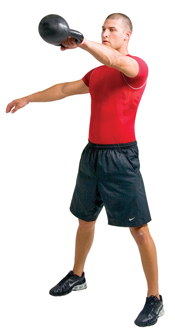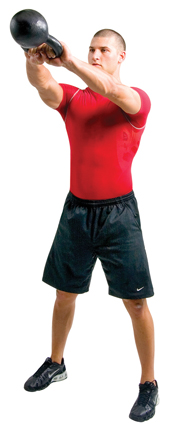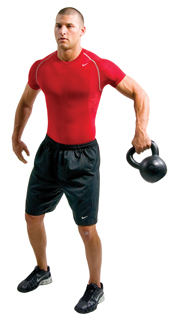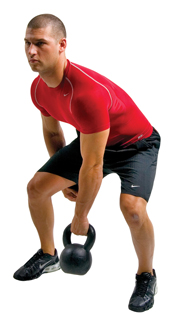
Kettlebell Comeback
Despite the kettlebell’s rich history, dating back at least to the 1700s, there are many people who have not yet heard of this tool. Only recently has the product caught the attention of mainstream fitness folks. Fitness pros and enthusiasts, both men and women, ranging from young to not so young, nonathletes to superstars, are starting to find use for the cast-iron tool that has its roots in Russia. The kettlebell may not be a new product, but creative programming using the age-old device is certainly “swinging” into action.
A kettlebell can best be described as a weight shaped like a giant cannonball with a single U-shaped handle. The kettlebell’s unique spherical shape provides the ability to work with curvilinear movements, centrifugal force and momentum. Often referred to as the “original Russian hand weights,” kettlebells are typically made of pure cast iron and come in a wide variety of sizes and weights, from just a few pounds to over 100 pounds. What began as a big, black, bulky piece of equipment attracting mainly men has been redesigned by today’s manufacturers. Many kettlebells can now be found in a variety of sizes, weights and colors, with the intention of attracting women. Cast-iron versions are still the most popular, though.
Kettlebells have always been common strength training tools in Eastern Europe. The word kettlebell actually appears in a 1704 Russian dictionary. In the 18th century, the kettlebell was used as a counterweight for market produce scales. Then farmers began to lift, swing and juggle the weight for exercise and fun. Eventually the kettlebell became a popular Russian training tool. In 1913, the Russian magazine Hercules suggested, “Not a single sport develops our muscular strength and bodies as well as kettlebell athletics.” Even the Russian military trains with kettlebells, favoring the kettlebell snatch test to gauge physical ability.
Kettlebells increased in popularity within the United States because of Pavel Tsatsouline. Tsatsouline is a fitness author and a previous trainer for both the United States and Soviet armed forces. In 1981, a committee for the sport of kettlebell lifting was created, and 4 years later, the first national kettlebell championship was held in the Soviet Union. Today, the kettlebell is working its way into mainstream fitness, having proven itself a useful strength-building tool.
Why Kettlebells?
While traditional strength training tools and techniques favor isolated, single-joint movements, there has been a trend toward more multijoint, multiplanar movements to create well-rounded, functional training programs. Kettlebell training takes functional training one step further by introducing momentum. Working out with a kettlebell can be a time-efficient way to improve cardiorespiratory fitness, plus muscular strength and endurance, while simultaneously enhancing balance, core strength, coordination and posture. Also, the movements performed with kettlebells typically recruit the entire body, which can shorten the time needed for a well-rounded workout.
Momentum training is one of the most unusual aspects of kettlebell training. Swinging the kettlebell increases rotation inertia, and the body recruits muscles to direct and control that momentum, thus mimicking real-life movements. Some fitness professionals may assume that this effect can be recreated with a dumbbell, but the design of a kettlebell provides unique training opportunities. As a result of the U-shaped handle, the center of mass sits outside the user’s hands. With movements performed in all planes, the weight becomes dynamic and the body must react to stabilize against the additional forces. A dumbbell, on the other hand, situates the center of mass in the hand, allowing the weight to remain constant throughout the exercise as the length and lever stay the same. This allows for strength gains, but not for the same functional gains that can be experienced from swinging a kettlebell, which adds elements of acceleration, stabilization and deceleration.
Of course, kettlebells are typically used in ballistic or swinging movements, but you can also perform standard press and pull strength training exercises. Displacement of weight from the hand requires the stabilizing muscles to engage more with each movement than would be required during a similar movement with a dumbbell. Kettlebell exercises are whole-body exercises requiring full-body integration and core stabilization.
Who Benefits?
With the wide array of choices and the
variety of exercises that can be executed, almost anyone can use a kettlebell. Fitness professionals need to match the needs (especially in terms of exercise selection) and abilities of clients with the appropriate type and size of kettlebell.
There are a number of reasons so many people like to use kettlebells. Men appreciate the heavier weight and the training specificity, while women enjoy the full-body workout, along with the heart-pumping nature of a continuous workout. Veteran exercisers find that the training regimen provides a new stimulus that jumpstarts their routines. And finally, everyone appreciates the straightforward, functional exercises that transfer easily to daily living.
An average female can swing a 15- to 25-pound kettlebell, though many women may opt for much less, owing to the “bulking up” myth. Many women new to kettlebells may underestimate the amount of weight they can lift, assuming that the arms do most of the lifting. These clients should try lighter weights at first and link together many kettlebell
exercises (both swing and nonswing) to elevate the heart rate while simultaneously training the muscles. Once swing technique is mastered, most women progress quite quickly with regard to weight.
An average male can swing a 25- to 35-pound kettlebell. Size will depend exclusively on the sequencing of movements and the length of time the client will be using the kettlebell. Typically, an “all kettlebell” workout will be quite taxing for anyone the first time through. An alternative is to combine swing movements with nonswing movements, putting the kettlebell down from time to time as a break.
Education & Training
Kettlebell training should be approached in much the same way as martial arts or even yoga. Although swinging kettlebells can be a very fun and functional activity, it is potentially very dangerous if not performed properly. Proficiency cannot be obtained by simply watching a DVD or attending a short weekend seminar. If you are interested in using kettlebells with clients, seek out reputable organizations that provide a live training with resources for furthering your knowledge once you leave. Many hours should be dedicated to perfecting the movements and techniques before you instruct any clients.
Respected organizations available to teach kettlebell lifting or training include the American Kettlebell Club; the Russian Kettlebell Club; the International Kettlebell Fitness Federation; CrossFit; and Kettlebell Concepts; so do your research.
Kettlebells, while not new, are quickly becoming the go-to training method for elevating functional workouts for a wide variety of clients. As long as both trainer and participant receive proper instruction, kettlebells can provide a safe, effective, time-efficient workout that engages multiple muscle groups, including the core. No muscle can escape a “swing” workout, so pick up a kettlebell when you have a chance!
Like any strength equipment, kettlebells can cause serious injury when used inappropriately. Proper use requires strength, coordination and practice. Because most swing exercises require a higher amount of weight than the participant can typically press or pull, technique is extremely
important. Each kettlebell
exercise involves multiple
joints and muscle groups plus momentum. It takes participants time to adjust to these new demands. Mastering the movement patterns requires guidance, instruction and
patience. The biggest mistake beginners make is lifting a
kettlebell that is too heavy to control. After the basics are mastered, increasing the weight can provide a strength workout unmatched by
machines or even dumbbells.
If you are concerned about using a traditional kettlebell, try a rubberized one. Specifically designed to counter any nervousness a participant or gym owner might have, the rubberized version offers a
great alternative.
For safety and personal comfort, you should allow plenty of space around each participant. In general, this would be about 35 square feet, or the same amount of space as you would normally allow around a step or BOSU® Balance Trainer.
Common Concerns
Back. Basic kettlebell moves require back endurance. They also strengthen the back extensors. Proper positioning includes core bracing, which has been shown to decrease back pain and strain. As with any exercise, it is important to learn correct form and technique to avoid back pain.
Shoulders. Increased range of motion and greater shoulder joint integrity can be achieved with proper kettlebell usage. Many people try to “muscle it up” and primarily use the shoulders, which can cause soreness or injury.
Arm Overload. At first glance, a kettlebell workout may seem to involve a lot of overload to the arms, because it appears as if the swings are done by pulling up with the arms. However, when done properly, the swing is all about “hip drive,” which trains the lower body and core. The back and shoulders act as stabilizers, not as primary movers, as they do not pull up or lift the kettlebell during the swing.
The most common kettlebell exercise is the swing. The swing should be viewed as the
foundation exercise and needs to be mastered before other momentum exercises are introduced.
The following exercises make up an introductory kettlebell “swing” session:

One-Arm Swing. Grasp handle with one hand in overhand grip with slight elbow bend. Position feet slightly wider than hip width, and assume athletic stance. Upper body should be
upright, with chest lifted and shoulder blades retracted. Free arm should be out to side of body. Rotate body slightly, allowing kettlebell to hang between legs. Initiate swing by rocking hips
(versus using shoulders to lift bell). Raise bell upward with momentum, and give forceful hip thrust at top of movement. Bell should go no higher than eye level, with bell pointed away from body at end of arm. Allow gravity to bring bell downward in controlled manner. Keep spine at neutral, rather than rounded, at bottom of movement. Perform desired number of repetitions.
One-Arm Alternating Swing. Repeat steps above
(one-arm swing), but switch to other hand at top of movement.

Two-Arm Swing. Perform in same manner as one-arm swing,
but with two-hand grip on handle.

Around-the-Body Pass (at waist level). Grasp handle with both hands in overhand grip with slight elbow bend. Position feet slightly wider than hip width apart, and assume athletic stance. Upper body should be upright, with chest lifted and shoulder blades retracted. Release one hand from bell, allowing opposite hand to bring bell behind body. Free hand should grasp bell at back of body and complete the rotation. Grasp kettlebell firmly to avoid dropping it. After desired number of repetitions, repeat in opposite direction.

Figure Eight (between the legs). Grasp handle with right hand in overhand grip
with slight elbow bend. Position feet slightly wider than hip width apart, and assume athletic stance. Upper body should be upright, with chest lifted and shoulder blades retracted. Left arm should be out to side and ready to accept kettlebell. Begin movement by handing bell from right hand to left hand through legs from front of body to back. Left hand then brings bell around from back of body to front of body. Continue this figure-eight pattern by passing bell through legs again from left hand to right hand. After desired number of repetitions, repeat in opposite direction.
As an introduction to kettlebells, these five exercises provide an appropriate full-body workout for most clients without physical limitations. After a full-body warm up, perform each exercise for approximately 30 seconds, rest and repeat. Mastery of the “swing” session can serve as the basis for progressing to longer, more demanding kettlebell workouts. You can also extend the workout with more traditional exercises, such as curls, overhead triceps extensions and bent-over rows.